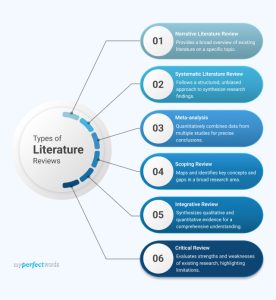Structure of a Literature Review in 2025
Structure of a Literature Review
How to structure a literature review: Like many other types of academic writing, a literature review follows a typical intro-body-conclusion style with 5 paragraphs overall. Now, let’s look at each component of the basic literature review structure in detail:

Introduction
You should direct your reader(s) towards the MOP (main organizing principle). This means that your information must start from a broad perspective and gradually narrow down until it reaches your focal point.
Start by presenting your general concept (Corruption, for example). After the initial presentation, narrow your introduction’s focus towards the MOP by mentioning the criteria you used to select the literature sources you have chosen (Macbeth, All the King’s Men, and Animal Farm). Finally, the introduction will end with the presentation of your MOP that should directly link it to all three literature sources.
Body Paragraphs
Generally, each body paragraph will focus on a specific source of literature laid out in the essay’s introduction. As each source has its own frame of reference for the MOP, it is crucial to structure the review in the most logically consistent way possible. This means the writing should be structured chronologically, thematically or methodologically.
Chronologically
Breaking down your sources based on their publication date is a solid way to keep a correct historical timeline. If applied properly, it can present the development of a certain concept over time and provide examples in the form of literature. However, sometimes there are better alternatives we can use to structure the body.
Thematically
Instead of taking the “timeline approach,” another option can be looking at the link between your MOP and your sources. Sometimes, the main idea will just glare from a piece of literature. Other times, the author may have to seek examples to prove their point. An experienced writer will usually present their sources by order of strength. For example, in “To Kill A Mockingbird,” the entire novel was centralized around racism; in “The Adventures of Huckleberry Finn,” racism was one of many themes.
Methodologically
As made obvious by the terminology, this type of structuring focuses on the methods used to present the central concept. For example, in “1984”, George Orwell uses the law-and-order approach and shows the dangers of a dystopia for a social species.
In “Frankenstein,” Mary Shelley exposes the character’s physical traits as repulsive and horrifying, forcing him to suffer in an isolated environment. By showcasing the various methods used to portray the MOP, the writer can compare them based on things like severity, ethicality, and overall impact.
Conclusion
After presenting your key findings in the body paragraphs, there are 3 final objectives to complete in the essay’s conclusion. First, the author should summarize the findings they have made or found, in other words, and briefly answer the question: “What have you learned?”
After discussing that information, the next step is to present the significance of the information about our current world today. In other words, how can the reader take the information and apply it to today’s society? From that point, we finish off with a breadcrumb trail.
As the author, you want to leave the readers’ trail of thought within the actual essay topic. This provides them with a means of further investigation—meaning that the reader may consider where the discussion will go next.
Source
